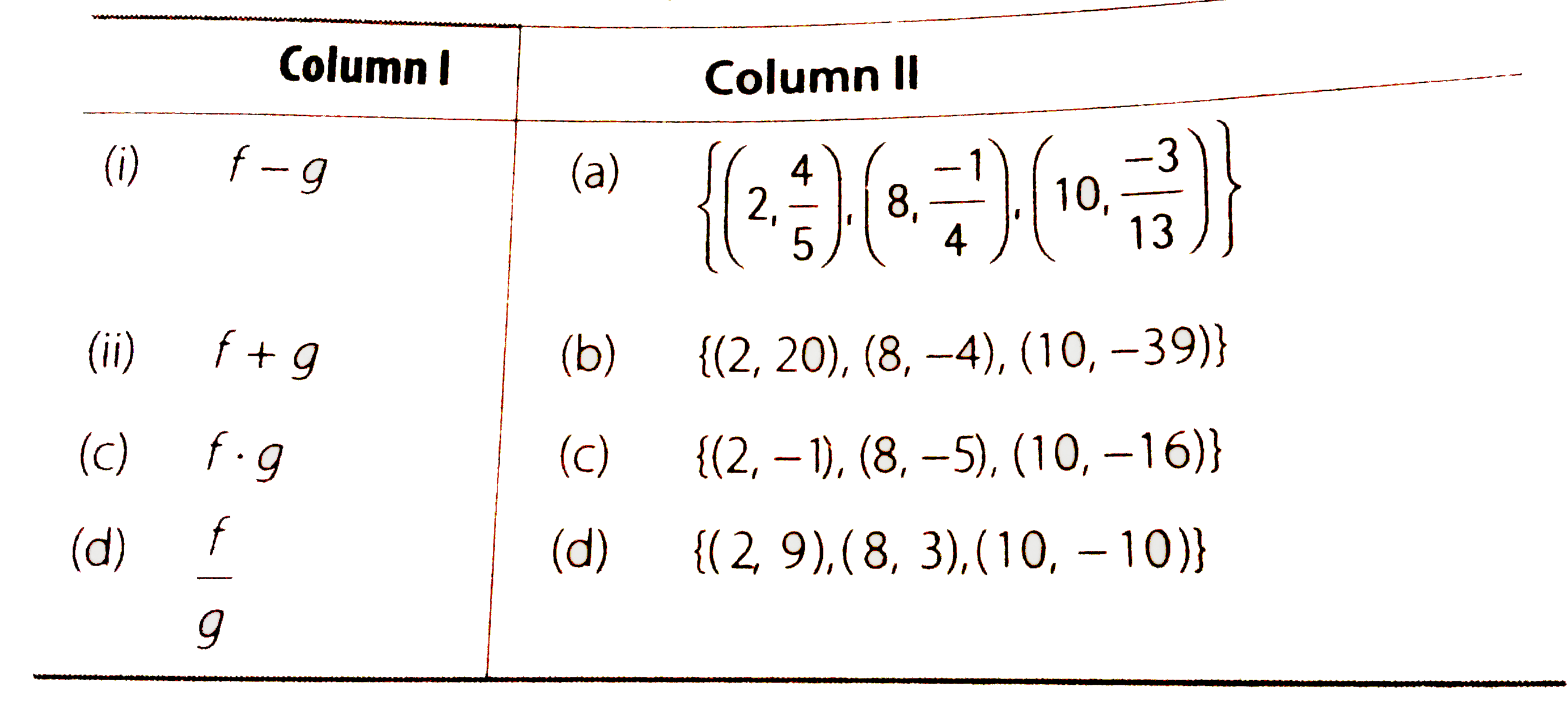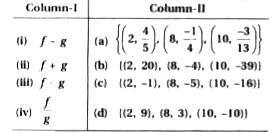मान लीजिए कि f={(2,4),(5,6),(8,−1),(10,−3)}
g={(2,5),(7,1),(8,4),(10,13),(11,5)}
दो प्रदत्त वास्तविक फलन हैं, तो निम्नलिखित का सही मिलान (Match) कीजिए :
(a)f−g(i){(2,45),(8,−14),(10,−313)}(b)f+g(ii){(2,20),(8,−4),(10,−39)}(c)f.g(iii){(2,−1),(8,−5),(10,−16)}(d)fg(iv){(2,9),(8,3),(10,10)}
Step by step video & image solution for मान लीजिए कि f={(2,4),(5,6),(8,-1),(10,-3)} g={(2,5),(7,1),(8,4),(10,13),(11,5)} दो प्रदत्त वास्तविक फलन हैं, तो निम्नलिखित का सही मिलान (Match) कीजिए : {:((a)f-g ,(i){(2,4/5),(8,(-1)/4),(10,(-3)/13)}),((b)f+g,(ii){(2,20),(8,-4),(10,-39)} ),((c)f . g ,(iii) {(2,-1),(8,-5),(10,-16)}),((d)f/g,(iv) {(2,9),(8,3),(10,10)}):} by Maths experts to help you in doubts & scoring excellent marks in Class 11 exams.
Updated on:21/07/2023Topper's Solved these Questions
- संबंध एवं फलन BOOK - NCERT EXEMPLAR HINDICHAPTER - संबंध एवं फलन EXERCISE - प्रश्नावली (दीर्घ उत्तरीय प्रश्न )
8 Videos
- शंकु परिच्छेदBOOK - NCERT EXEMPLAR HINDICHAPTER - शंकु परिच्छेदEXERCISE - प्रश्नावली (वस्तुनिष्ठ प्रश्न )
29 Videos
- समुच्चयBOOK - NCERT EXEMPLAR HINDICHAPTER - समुच्चयEXERCISE - प्रश्नावली वस्तुनिष्ठ प्रश्न सत्य या असत्य
6 Videos
Similar Questions
क्या g(x)={(1,1),(2,3),(3,5),(4,7)} का फलन है ? औचित्य भी बताइए। यदि इसे नियम g(x)=αx+β द्धारा वर्णित किया जाये तो α और β को क्या मान दिया जा सकता है ?
View Solutionदर्शाइए कि ऐसे सभी बिंदुओं का समुच्चय जिनकी (4,0) एवं (-4,0) से दूरी का अंतर हमेशा 2 है एक अतिपरवलय को निरूपित करता है।
View Solutionयदि A कोई समुच्चय है, तो A⊂A
View SolutionIf f(x),g(x) be twice differentiable function on [0,2] satisfying f''(x)=g''(x) , f'(1)=4 and g'(1)=6,f(2)=3,g(2)=9,then f(x)-g(x) at x=4 equals to:- (a) −16 (b) −10 (c) −8
View SolutionLet f={(2,4),(5,6),(8,−1),(10,3)
and g={(2,5),(7,1),(8,4),(10,13),(11,5)}
be two real functions. Then, match the following .

The domain of f−g,f+g,f⋅g,fg is domain of f ∩ domain of g. Then, find their images.
View SolutionLet f={(1,6),(2,5),(4,3),(5,2),(8−1),(10,−3)} and g={(2,0),(3,2),(5,6),(7,10),(8,12),(10,16)}. Find (i)dom(f+g)(ii)dom(fg).
View Solutionमाना कि A = {1,2,3,4,5}. माना कि f:A→A तथा इस प्रकार परिभाषित है कि, f(1) = 2, f(2) = 3, f(3) = 4, f(4) = 5, f(5) = 1 तथा g(1) = 4, g(2) = 1. g(3) = 1, g(4) = 2, g(5) = 3. फलन fog तथा gof निकालें ।
View SolutionState with reason whether following functions have inverse (i) f:{1,2,3,4}→{10} with f={(1,10),(2,10),(3,10),(4,10)}
(ii) g:{5,6,7,8}→{1,2,3,4} with g={(5,4),(6,3),(7,4),(8,2)}
(iii) h:{2,3,4,5}→{7,9,11,13} with h={(2,7),(3,9),(4,11),(5,13)}
View SolutionIf f(x), g(x) be twice differentiable functions on [0,2] satisfying f''(x)=g''(x) ,f'(1)=2g'(1)=4 and f(2)=3g(2)=9, then f(x)−g(x) at x = 4 equals (A) 0 (B) 10 (C) 8 (D) 2
View SolutionIf f(x), g(x) be twice differentiable functions on [0,2] satisfying f''(x)=g''(x) ,f'(1)=2g'(1)=4 and f(2)=3g(2)=9, then f(x)−g(x) at x = 4 equals (A) 0 (B) 10 (C) 8 (D) 2
View SolutionLet f a n d g be two functions given by f={(2,4), (5,6), (8,-1), (10 ,-3)} a n d g={(2,5), (7,1),(8,4),(10 , 13),(11,-5)}. Find the Domain of f + g
View SolutionIf f:{3,4,5,6}→{4,5,6,10} and g:{4,5,6,10}→{8,12,16} are two functions such that: f{3)=4, f{4)=5, f{5)=f{6)=6 and g(4)=g(5)=5 and g(6)=g(10)=12, then the value of gof(5) is :
View SolutionLet f:{1,3,4}→{3,4,5} and g:{3,4,5}→{6,8,10} be functions defined by
f(1)=3,f(3)=4,f(4)=5,
g(3)=6,g(4)=8,g(5)=8,then (gof)(3)=……...
View SolutionSuppose f and g are the following two functions, f={(2,4),(5,6),(8,-1),(10,-3)} g={(2,5),(7,1),(8,4),(10,13),(11,-5)} so f+g The province of will be ______.
View SolutionLet f={(2,4),(5,6),(8,−1),(10,−3)andg{(2,5)(7,1),(8,4),(10,13),(11,5)} be two real functions. Then, match the following.

The domain of f−g,f+g,f.g,fg is domain of f∩ domain of g. Then, find their images.
View Solution
